|
|
 |
|
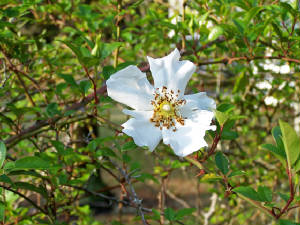
|
| Cherokee Rose |
Georgia's state flower is the Cherokee Rose.
Georgia's state wildflower is the Azalea.
Georgia's state bird is the Brown Thrasher.
The state motto: Wisdom, justice, and moderation.
If you want to know the state insect, you will find your answer buried below.
|
 |
Thursday, March 24, 2005
Fernandina Beach to Jekyll Island, GA (32.3 miles)
We bid farewell to Fernandina at 8:15, with Amelia Coffee lattes and pastries beside us on the flybridge.
As we started our engines and were making last minute preparations to depart, we noticed lots
of jellyfish floating by the boat. They looked like exotic flowers with pink and red petals and saffron gold centers,
encased in jelly. As they moved, the jelly pulsed in a way that looked like the flower inside was opening and closing.
They ranged in size from just a few inches in diameter to over a foot in diameter. They were fascinating to watch, but
we had to be on our way.
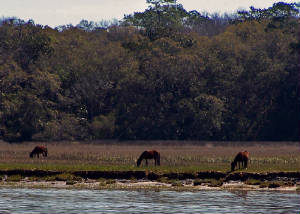
|
| Wild horses on Cumberland IsIand |
On this leg of our journey, we passed through two sounds that can get very unpleasant if winds are
unfavorable or seas are rough. A sound is a body of water, usually large, where a river meets the ocean. The winds
were calm and the water was smooth for us almost all day, and we passed gently through both Cumberland Sound and St. Andrew
Sound.
There is a stretch of the ICW that passes close to a grassy shore of Cumberland Island where wild
horses sometimes graze. We were lucky today, and saw three horses. On our way south, we had heard people
on our VHF radio talking about seeing them, but by the time we got to the spot, they were gone.
We got to Jekyll Harbor Marina at noon, and soon had a wonderful surprise.
Dick went to the marina office to register, then stepped next door to check out the marina restaurant.
Sitting right in front of him eating lunch on the restaurant porch were Bob and Jane Steward, our favorite couple from a
birding tour to Costa Rica two years ago. They have been coming here in March to camp with Jane's sister and her
husband -- Karen and Ted -- for nine years now. We sat and talked a while, then invited
them to come back later in the afternoon with Karen and Ted for cocktail hour aboard Starsong.
Then, we spent a couple hours biking around the island. We checked out the Jeckyll Island
Club, a 250 acre village founded by 53 northern industrialists in 1886. They bought Jekyll island for $125,000, and
spent an additional $45,000 to build an elegant Clubhouse with rooms where members and guests could stay. Then they
laid out 50 building lots, assuming most members would want to build their own cottages, rather than staying in
the Clubhouse. It turned out that only 15 members built "cottages," and 12 of them are still standing.
Today, the Clubhouse is a four star hotel, complete with a croquet court where we saw people in white playing
a serious game on the impeccably manicured lawn. We vowed to come back tomorrow for a tram tour of the grounds of this fascinating
place.
Then we went to the IGA to reprovision a bit, and took a bike trail through pine and palmetto woods to get
back to our boat.
Shortly before our cocktail hour guests arrived, Change-o-Pace III pulled in a day ahead
of schedule. The currents and winds and bridge opening schedules all worked in Bev and Liz's favor, and they
traveled 92 miles from St. Augustine to here in one day!
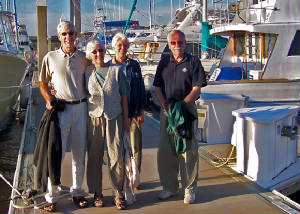
|
| Bob, Jane, Karen, and Ted |
We had a great time catching up with Bob and Jane Steward, and getting to know Karen and Ted. We tried
to convince Bob and Jane to join us for a leg of our voyage, and hope they will take us up on the offer. They were great
traveling companions in Costa Rica, and seem not to have changed a whit since then.
When dinner time rolled around we went up to the Marina Restaurant, Sea Jays, with Bev and Liz. The
restaurant specialty is a low country boil -- shrimp, potatoes, corn on the cob, and spicy sausage served in a big vat,
all you can eat buffet style. Cole slaw and rolls on the side and banana pudding for dessert are all included in the
$14.95 price. Dick and I had to give it a try. Once was probably enough.
Friday, March 25-Monday, March 28, 2005
Jekyll Island Goes Jekyll and Hyde on Us
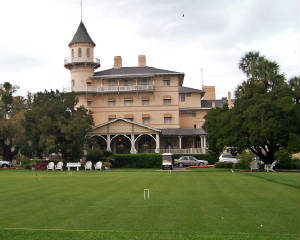
|
| Jekyll Island Clubhouse |
A storm arrived Thursday night, bringing intermittent thunder, lightning, and wind-driven rain that persisted
into the morning. Just as we would think the storms were over and we still might be able to make the 11 am Jekyll Island Club
Tram Tour, another rainstorm would pass through.
The Jekyll Island Club
After lunch, we decided the rain was probably just about gone for the day, and we rode over to the Club
for the 2 pm tour. The tour took two hours, and included stops at two of the cottages, where we could walk through the
homes restored to the casual elegance of their past days "in season "-- January-March. The rest of the year, the Club
and homes were shuttered, except for the residences of the year-round staff members and their families.
Club members included J.P. Morgan, the Rockefeller brothers, Vanderbilt, Astor. . . most of the movers
and shakers of the time. In fact, 1/6 of the world's wealth was concentrated on the island in season. Pulitzer,
of publishing fame and fortune, was the only Democrat in the club. He was also Catholic, and Club rules banned Catholics,
but members didn't dare discriminate against him for fear of the bad press Pulitzer could unleash on them in retaliation.
These millionaires were high maintenance people. The ratio of servants to Club members and guests
was 7/1.
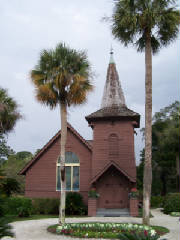
|
| the tiny church |
One of the Club's claims to fame is that its tiny church has one of the five Tiffany stained glass
windows known to have been personally installed by Louis Comfort Tiffany. The church is open from 2-4 pm, when the sun
is low and the window is radiant.
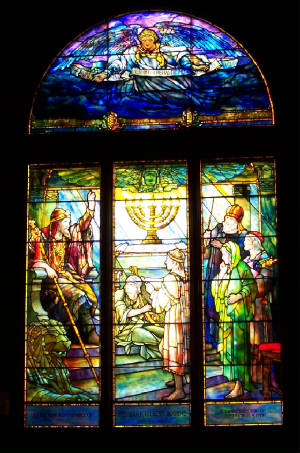
|
| The big Tiffany window |
Another of the Club's claims to fame is that it was the site of the first transcontinental phone call.
In 1915, Theodore Vail, President of AT&T, used a phone on the Island to call Alexander Graham Bell in New York City,
then added President Woodrow Wilson in Washington DC, and Bell's assistant Watson in San Francisco.
The Club's last season was in 1946. The Great Depression had affected the fortunes of some members.
Palm Beach had been developed by then and established itself as the next social hub for the rich and famous. And, the
next generations of some families just weren't interested in this island paradise anymore.
Their loss is our gain. The state of Georgia has owned the island since 1947, and has by law designated
that 65% of it will remain undeveloped. There are over 20 miles of paved bike trails, and lots more unpaved trails
for walking and mountain biking. Beach access parking spots are plenitful and free. Anyone can park free
and wander around the Clubhouse and surrounding historic district.
Our only complaint is about the no-see-ums, who are out in force now, and resistant to all but the most
copious applications of DEET-containing bug spray or a very aromatic local herbal product called "Swamp Buddy."
By the end of our Tram Tour, everyone was swatting furiously at the ever-increasing swarms of these pesky
gnats who don't bite, but instead poop a little poison on your skin that stings and welts up like a bite (or, at least,
that's what we've heard from multiple sources who seemed credible at the time). We had two
decent rain showers during the tour, and the rain didn't seem to faze the bugs.

|
| Moss "Cottage" (1896) |
Friday night the Laphams had us and three other friends over for a spaghetti dinner on Change-O-Pace
III. It was the perfect dinner for a rainy day. The food was delicious and plentiful, and the conversation
lively with lots of laughter. No rainy day blues here. Dessert was a tart-sweet Key Lime Pie that Dick bought
at the Clubhouse Cafe, possibly the best Key Lime Pie we have had yet (and we have sampled many).
A Foggy Day in Jekyll Town
Saturday, after rain in the night, we woke to zero visibility fog. Fog makes us move slowly, as though
we are swimming through thick air. Even when we are just inside looking out at it.
By a bit after 9 am, we decided to venture out on our bikes, since the fog seemed to be lifting. Our goal
was to get the New York Times, a cinnamon roll, and coffee at the Clubhouse Cafe, then search out as many of the eight geocaches
on the island as we could find before the predicted rainstorms hit us this afternoon.
Just as we got to the end of the dock, the Stewards met us. They had come to show us a grand birding
spot nearby with a wood stork rookery. We convinced them to join us for coffee and pastries first. We enjoyed
the sun on the deck of the Clubhouse, overlooking a formal courtyard with a sparkling fountain.
Then we piled in the Stewards' car and drove to the head of the trail to the great birding spot. Dick fired
up the GPS, suspecting that this spot was near a geocache. He was right, so after the Stewards introduced us to the birds,
we introduced them to geocaching, locating the cache about 100 yards from where we stood admiring the birds.
This was an extraordinary birding pond. In addition to the tall dead tree covered with about
20 wood storks and two nests in process, we saw 12 other varieties of birds, including a roseate spoonbill, both black- and
yellow-crowned night herons, anhingas in their breeding plumage with exotic turquoise eyeliner, and great egrets spreading
the fancy airy plumes that once were coveted as trim for hats. We also saw an alligator and lots of sunning turtles.

|
| Wood Storks Roosting |
After our great birding stop, the Stewards dropped us off by our bikes, and we headed off in search of more
caches. The fog returned, misty over the land, and thick over the water. This is the first time we have seen fog
that seems to burn off, then returns and lasts all day.
Our search took us to woods of palmetto and moss-draped llive oaks, and to the wide beach at the southern
end of the island. We left our bikes and walked about 3/4 mile down the beach to a point where we had seen lots of shorebirds
from our boat, and just as we got there, the skies opened on us. Dick had the foresight to be wearing his foul weather
jacket; Gayl did not. Fortunately, the rain stopped shortly after we turned around, and it was so windy that we were air-dried
before we got back to the bikes.
When we arrived back on the docks, we saw that the Grand Banks behind us who had left in a brief clearing
of the fog this morning had returned. The captain said he was out for half an hour, couldn't see a thing, and came back
right away.
As the day wore on, the weather deteriorated, and the rain became more frequent. At night, storms
woke us up.
Easter Sunday
Our plan called for us to leave today, but weather intervened. More storms and high winds are forecast.
We have to be especially cautious, because on the day that we leave, the nearest marina is 90 miles away, really too far for
us to travel in a day, making it necessary to anchor out. Because we are in the Low Country, an area of wide tidal marshes
stretching out from low elevation land, protected anchorages are few and far between.
So we had another day in paradise. The morning was clear and breezy. We decided to take our bikes
to explore the north end of the island. (The island is 8-1/2 miles long, and 1-1/2 miles wide.) We followed
a bike path along the island's western shore, overlooking the ICW and wide swaths of marshes, and ocasionally passing through
old growth woodlands.

|
| Our bike trail shortcut |
We made frequent stops along the way to read historical markers and look at remains of a fort, the family
graveyard of the first family to own the Island (they kept it for five generations, beginning in the 1700s), and the
ruins of several historic homes pre-dating the Club. There were lots of other families with bike helmets and colorful tee
shirts in Easter egg colors out on the bike trail with us, reminding me of the song, "In your Easter bonnet, with all the
ribbons on it, you'll be the finest lady in the Easter parade."
We found two caches on the north side of the island. The first was in a wooded area off the northern
end of Driftwood Beach. The second was at the southern end of the beach. Dick took us on a shortcut trail
through the palmetto and pine forest to get there, but we found that with all the recent rain, there were many ponds in the
trail to ford.

|
| Driftwood Beach |
Driftwood Beach, at the Island's northern shore, is aptly named. The beach is wide, flat, and littered
with driftwood trees that have lost their toe-hold on the woods that border the beach as north wind storms and waves
have buffeted them. The tide was out pretty far, and the sand was hard enough that we could ride our bicycles on it.
As we looked over St. Simon's Sound to the lighthouse after finding our caches, we could see a storm building,
so we headed back, this time taking the bike path along the Island's eastern shore.
I'm sure you can guess what happened next. Before we could make it back to the boat we were caught
in a drenching downpour. Sure, we had on our rain jackets, but we were thoroughly sopped below the waist. We didn't
care--we had found all eight of the caches hidden on this island!
We changed into dry clothes, made nice hot and buttery toasted ham and cheese sandwiches for lunch,
and hunkered down for some serious Easter egg dying. After dying our eggs, we pulled out my Crayola glitter
glue pens and embellished some. Then I wrapped up half a dozen for the Laphams, and ran down to their boat
to deliver them when we got a break in the rain. When I got there, Liz said, "I have a gift for you," and I said, "I
have a gift for YOU." I gave them the eggs we made, and she gave me one of her pots of herbs. I met their daughter Wendy
and her friend John, who came to visit for Easter Break. Our chat was cut a bit short as a boat arrived in the wind
and rain, and no dockhands emerged to help them handle their lines. We jumped out to help, and, after they were secured,
heard their hair-raising adventures crossing St. Andrews sound in the stormy weather.
Stormy Weather
We knew when we listened to the weather radio on Sunday night that there was a chance we wouldn't be able
to leave Monday morning either. We figured we would listen to the radio when we woke up and decide then.
It was a very easy decision. We woke up to punishing winds at 3:45 am. The boat was being pounded
by the waves and wind, and we could hear the bimini straining and shuddering. Dick ran up top to open all the windows
in the eisenglass enclosure to take the strain off. The wind seemed to let up a bit, and we went back to sleep until
about 6, when the wind began howling and we began tossing about again. We listened to the weather radio, and had no hope of
winds subsidiing all day.
The day dawned clear and sunny. The skies were blue. But the wind increased to 25-30 mph, with gusts
to 40 by about 9 am. Water was washing over the docks. We looked out and saw with alarm that one of our fenders
had bounced out and was lying on the dock, and another was in imminent danger of doing the same.
We jumped out to fix our fenders, and realized there were other boats in distress all along the dock. With
the strength of the wind, about five people needed to lean against our boat to push it out enough to get the space to
shove a fender between the boat and the dock. The same was true of other boats. So, for several hours of the morning
we stood watch by our boat as waves threatened to push the fenders up and out again, and we (mostly Dick) ventured
down the docks helping others get their boats secured. Some boats suffered significant damage as the winds
bounced them against the docks. But as the day wore on, and most boats were stabilized, the men wandering the docks
spent more time in socializing mode, and less time in crisis management.
For the third day in a row, we found ourselves soaked, this time with salt water spray. Yep, we sure could
have used our foul weather gear pants again today. We looked with envy at all the people passing in yellow head to toe.
At lunchtime, Dick had the inspired idea of going up to Sea Jay's, the marina restaurant, for take-out Crab
Chowder. It was the perfect antidote to this weather. It tasted as though it was made with cream cheese in the rich
and thick base, and big chunks of crab seemed to come up in just about every spoonful.
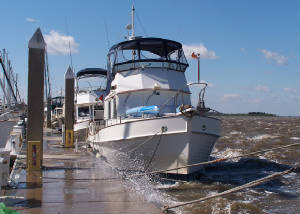
It is now nearly 6 pm, and we have been tossing about all day in the wind and waves. According to
the weather radio, the winds should subside by tomorrow. We hope so. We have a good three days of travel left
to get to Beaufort, where we need to drop off our boat for work and pick up our rental car to drive home by Friday.
Tuesday, March 29, 2005
Jekyll Island to Duplin River Anchorage (36.8 miles)
Yesterday's winds began to diminish after 8:30 in the evening. We were able to sleep without worrying
too much about the boat. As dawn broke, the wind began to build again, but not to anything like yesterday's gale force proportions.
We were confident enough in the weather to take a walk over to the Historic District for one last coffee
and cinnamon roll on the sunny deck of Cafe Solterra at the Clubhouse.
Besides the cinnamon roll, we had two other important reasons for wanting a good morning walk. One
was that we had been bouncing so much yesterday, we craved a little stabilization of our sea legs and inner ears on terra
firma. The second was that we feel much better when we get some exercise every day, and we knew we wouldn't get
off the boat at this afternoon's anchorage.
We were off the dock at 9:20, and saw our first dolphins of the day at 9:45. The sky was a pure clear
blue and the sun was warm, but the wind churned up the waters, making our voyage through the open water areas rougher
than we had hoped for, but no cause for seasickness either.
We are beginning to look forward to lighthouse sightings. On this leg of our voyage, we saw the Sapelo
Island light, now abandoned, but distinctive by day with its red and white striped tower.
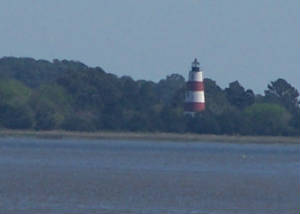
|
| Sapelo Island Light |
We found a sheltered spot along the Duplin River next to Little Sapelo Island, with high banks (at low tide
anyway) and lots of trees providing protection from all winds with West in them. As it came to pass, we really
didn't need the protection. The wind died and the water was glassy calm.
We actually would have preferred a bit of wind to blow away the no-see-ums, who swarmed to greet us from
the moment that we anchored. We spent an hour or two relaxing on the flybridge with our books, drinks, and three different
types of insect repellent at our side, but around 5 pm, when the night shift came on, we gave up and enjoyed the serene view
of palmettos and pines from inside the salon.
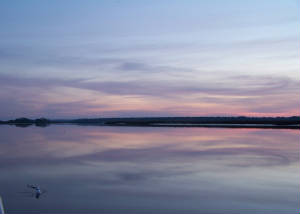
|
| Dawn on Duplin River |
Wednesday, March 30, 2005
Duplin River to Thunderbolt
(66.7 miles)
We woke to a beautiful and dramatic dawn, reflected flawlessly in the glassy water of the river. We
did pause to watch the sky change colors as the sun rose, but once it cleared the horizon, we didn't dilly dally--our anchor
was up and we were on our way at 7:35.
We needed to get an early start, because we had a long mileage day ahead, and we also had a lot to do once
we got to Thunderbolt. The boat was encrusted with salt from top to bottom, as a result of the stormy weather at Jekyll
Island, so it badly needed a thorough washing. We also needed to get packed and organized to leave the boat
in Beaufort tomorrow. We are going home for a brief visit, while Starsong has her depth sounder replaced at the boatyard.
In addition to our daily dolphins, today we saw an otter swim across our bow. As we passed, he surfed
the waves of our wake, then returned to his course straight across the river again. We also saw a bald eagle high in
a dead tree.
As if all the wonders of nature around us weren't enough, Dianne Rehm had as her guest today a bee keeper,
and we enjoyed learning more fascinating facts about bees. The most amazing fact: bees have to visit about two
million flowers to make a pound of honey. This topic is very appropriate for our travels through
Georgia, since Georgia's official website indicates that the honeybee is the state insect.
Thursday, March 31, 2005
Thunderbolt, GA to Beaufort, SC
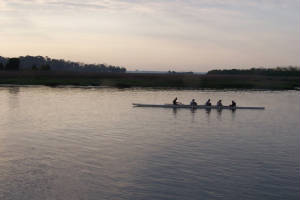
|
| Rowers in the morning |
One of the distinct pleasures of a stay at Thunderbolt Marina is beginning the day with a half dozen very
fresh Krispy Kreme donuts delivered to your door. You have to walk up to the office for the coffee, but it is plenty
good, and hot.
We left the dock at no wake speed, since several teams of rowers were out on the river practicing.
As we cruised slowly, sipping our coffee and nibbling the donuts, watching the rhythmic pulling and feathering of the
rowers as they cut through the smooth water, we enjoyed the serentity of the morning, marred only slightly by the no- see-ums.
Just a short way upriver from Thunderbolt, Bonaventure Cemetery came into view. Made famous in 1994
by John Berendt's book, Midnight in the Garden of Good and Evil, and the Clint Eastwood movie of the same name featuring
some scenes filmed here, the cemetery is a beautiful place with a rich history.
In 1771 John Mullryne and his son-in-law Josiah Tatnall purchased 600 acres of land here and established
a family plantation named Bonaventure, from the French for "good fortune." By 1846, the last son of the family sold
Bonaventure to a Savannah businessman who set aside 70 acres for a public cemetery. The city of Savannah bought the
cemetery in 1907.
The cemetery is filled with beautiful statues, monuments, and family chapel buildings, set amid live oaks
draped with Spanish moss. There are ponds, fountains, gardens and benches throughout. This cemetery
was established and developed during a time when people visited cemeteries like parks, strolling and picnicking and socializing
there.
During our last visit to Thunderbolt, we rode our bikes the short distance from the boat to the cemetery,
and we stopped often to admire the statues of angels and cherubs, draped urns, tree trunks, and other icons of death.
We visited the graves of poet Conrad Aiken, song writer Johnny Mercer, and Civil War heros. Today, by boat, we
could see that azeleas were in bloom--copious mounds of red and coral and pink along the ground, while mists of white
dogwood blooms floated above. Wisteria hung lavender from trees and trellises. It would be a beautiful time to visit
the cemetery.
We made our way to Beaufort, South Carolina, on schedule, and got to Marsh Harbor Boatworks at high
tide. Our weather radio warned of chances for high winds building in the afternoon and into the evening, so we took down
all our isinglass enclosures and stored them safely away. We securely stowed everything that might get blown around,
packed up, got our rental car, and headed north for home.
|
 |
|
|
 |
|
|
 |
|
|
|
|
|
|
 |

